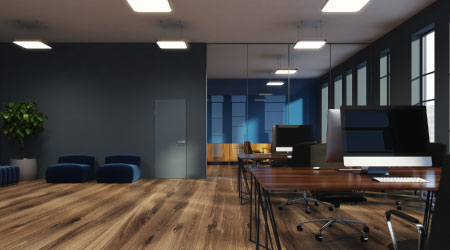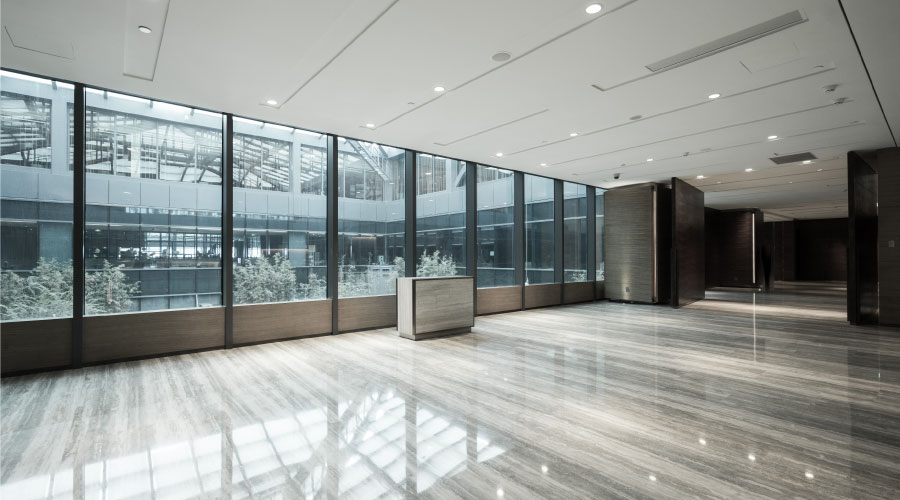Resilient Flooring: Strategies for Success
Resilient flooring offers facilities a range of benefits, but like any other flooring, proper care is essential
As visitors and occupants enter facilities, one of the first elements of the physical structure that they undoubtedly notice is the facility’s flooring.
Flooring in commercial and institutional facilities has a direct impact upon the image formed in the mind of the customer entering a building, and first impressions count. Housekeeping managers responsible for cleaning would be wise to spend some time considering the ways in which their floors are maintained and the appearance of floors in their facilities on a daily basis.
Resilient Floors
Among the many types of floor coverings available today is a category called resilient flooring. Resilient floor coverings include vinyl sheet goods, vinyl composite tile, linoleum, rubber and cork. The primary reason such floor goods are called resilient is because of their inherent ability to spring back and be flexible when applied on a floor surface. Resilient floor coverings are quite flexible, hence the name resilient.
But no matter which type of floor covering is installed, building owners expect that the floors will look clean and last as long as humanly possible before replacement. Thus, housekeeping managers must make sure that floor surfaces are maintained at their optimal level to ensure both the floor’s appearance and its extended performance life.
The World Floor Covering Association says today’s resilient floor types are “extremely durable and long lasting, but like any floor covering, they still need regular maintenance to stay looking like new.” This statement is critical. If a manager wants his or her resilient floor coverings to look fresh and clean and have a long life, a proactive floor-cleaning program needs to be established.
Because of their flexible nature, resilient floor coverings can be used most anywhere. They are installed most often in hospitals, airports, educational institutions and other types of facilities too numerous to mention. The main reasons for the popularity of resilient floor coverings are flexibility, multiple color schemes, ease of cutting and installing, durability and ease of cleaning.
Many resilient coverings also can mimic the look of original ceramic tiles, various stone surfaces and even wood products. Resilient products are easy to clean, especially if housekeeping crews makes efforts to keep dirt off the surfaces in the first place, and secondly, if an active cleaning maintenance program is in place to remove dirt regularly.
Floor-care Program
Maintaining resilient flooring — or any type of flooring, for that matter — is relatively simple, but the schedule of cleaning must match the flow of foot traffic in and out of the building. A step-by-step approach to floor cleaning will help ensure that when visitors and occupants look at the floor, it is clean and shiny.
Walk-off mats. Use walk-off mats to keep floors free of dirt and debris. This is the simplest of steps, as it is estimated that upwards of 80 percent of dirt that enters buildings can be kept out by using a walk-off mat. Mats should be long enough for a person to walk several paces. If space is too confined to allow this distance, consider installing an exterior walk-off mat and an interior one.
The more a person walks on a walk-off mat, the greater the amount of dirt that is blocked from entering a building. Walk-off mats should be of good quality, and the backing should be a non-staining material so as not to discolor the floor underneath. Housekeeping workers should sweep off or vacuum mats daily.
Fast clean-up. Once spills occur on flooring, housekeepers should damp- mop the spill immediately or as soon as noticed. The longer a spill remains, the greater the probability of staining the floor or making it sticky and dirty, as the other visitors track it around the building. Also, removing liquid spills from floors immediately minimizes the chance of someone slipping.
Routine cleaning. Routinely, floors should either be dust-mopped or vacuumed. Since grit and sand have sharp edges and can literally cut the floor’s wear layer or finish, dust-mopping or vacuuming should be performed daily to maintain optimal appearance.
Regular mopping. Floor should be damp-mopped regularly using a floor cleaner recommended by the floor-covering manufacturer. Usually, a mild or neutral cleaner is adequate for this type of cleaning.
Obviously, before mopping, floors should be dust-mopped or vacuumed to remove as much dirt as possible. Depending upon climate and location, housekeepers might have to perform this task daily, every other day, or several times a week.
Finish removal. If walk-off mats, dust-mopping and damp-mopping do not keep the dirt off the floor surface, housekeeping managers might have to apply a finish. Prior to doing this in some cases, housekeepers might have to remove the old finish. If a floor covering was installed only with a manufacturer’s protective coating, remove it using a floor stripper, an abrasive pad and a rotary floor machine.
When performing this task, equipment operators should use enough water and stripping solution to keep the floor wet, though not enough to over-wet the floor. Any chemicals or products used to do this task should be consistent with the manufacturer’s instructions.
Sealer application. After the old finish and dirt have been removed, a floor sealer or floor finish is applied in several coats to create a shine on the floor and to essentially replace the old wear layer.
Floor buffing. After this process is completed, the housekeeping manager might opt to regularly buff the floors using a buffing machine. Again, managers should consult the manufacturer’s directions about this step.
Some floor finishes allow for the use of a high-speed buffer or burnisher. It is the high-speed burnishing step that creates the wet or glass look on floors that many customers prefer.
Fine-tuning
Besides providing a step-by-step cleaning program for the regular maintenance of resilient flooring, the housekeeping manager can extend the life of this floor type by fine-tuning the program with these floor-care procedures:
- Remove sticky substances, such as gum, as soon as possible using an object such as a spatula that will not damage the floor’s surface.
- Don’t use abrasive cleaners or solvents on floors. Steel wool might clean certain fixtures well, but it is not for floor cleaning.
- Make sure chair glides are in good repair and that glides used under the furniture are the right type for resilient floors.
- Place floor protectors under heavy items such as pianos and desk legs.
- Check the conditions of floors regularly to ensure an optimal level of cleanliness and repair.
- Use appropriate furniture-moving carts with wheels that are compatible with resilient flooring. Wheels that are either too small or too hard will damage resilient flooring.
The appearance and life expectancy of any floor covering is directly related to the type of floor maintenance. Ideally, every floor surface should be dust-mopped and damp-mopped daily, with periodic buffing as necessary.
But if some of the steps have to be skipped or delayed to another day — dust-mopping on alternate days, for example — then the use of quality walk-off mats is imperative. And these should be kept clean at all times so that dirt is not tracked into the building.
Resilient floor covering affords housekeeping managers a floor covering that is easy to maintain, durable and flexible. By following a proven series of steps, managers can bring resilience to their floor-care program and ensure that the floors in their facilities are maintained at an optimal level.
A Closer Look at Resilient Floors
For housekeeping managers considering resilient floor coverings, it is worthwhile discussing the construction of these types of floor coverings.
The floor covering has a backing, a vinyl core layer and topcoat, or wear layer, on top. The wear layer is clear, and it is this topping of the floor covering that protects the vinyl. The objective of any cleaning program is to protect the topcoat from getting dirty and being damaged by dirt and grit. Once a topcoat becomes dull or wears off, more aggressive cleaning will result, including the application of floor finishes.
Depending upon the type of resilient floor goods installed, it is possible that the vinyl composite tile or vinyl goods were sealed by the manufacturer with a protective coat only, and that cleaning crews might have to apply the final finish coat after the floor is installed. The manufacturer’s protective shipping coat should be removed first.
Managers should carefully read the manufacturer’s directions about installation, sealing of the flooring, if necessary, and steps for routine maintenance and cleaning.
|
Related Topics:











